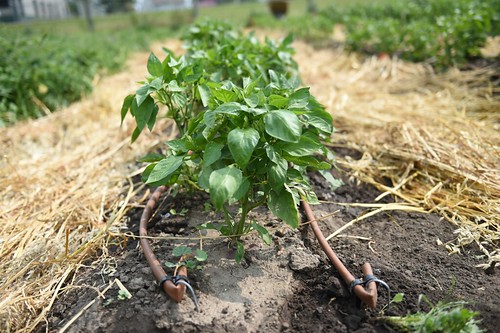
USDA celebrates National Native American Heritage Month in November with a blog series focused on USDA’s support of Tribal Nations and highlighting a number of our efforts throughout Indian Country and Alaska. Follow along on the USDA blog.
When the Cheyenne River Youth Project (CRYP) first began its organic garden in 1999, staff members at the 26-year-old not-for-profit youth organization scarcely could have imagined where that little garden would take them. Now, 16 years later, the thriving two-acre Winyan Toka Win (“Leading Lady”) garden located in Eagle Butte, South Dakota is the beating heart of the youth project — and it’s quickly becoming a veritable micro farm.
Today, sustainable agriculture at CRYP supports nutritious meals and snacks at the main youth center for children four to twelve and at the Cokata Wiconi teen center. It also provides fresh ingredients for the seasonal Leading Lady Farmers Market. To continue pursuing the long-term vision for the initiative, CRYP has invested in a new irrigation system, a composting system and a garden redesign.
The most recent garden upgrades began last fall when CRYP began the process of installing the new irrigation system, made possible through the USDA Rural Development Community Facilities program.
Julie Garreau, CRYP’s executive director, said she hopes the new planting areas and water system will allow the youth project to increase its yields by up to 50 percent and also to increase outdoor-classroom use among teen interns who wish to become gardeners and farmers.
The internships available for youth summer interns, ages 12-17 allow work on special wellness projects and on programs related to the two-acre, naturally grown, pesticide-free Winyan Toka Win garden.
Interns commit to working a total of 60 hours at CRYP’s East Lincoln Street campus before school resumes in the fall. Thanks to funding from Diabetes Action Research (DARE) each intern receives a $500 stipend at the conclusion of his or her summer internship.
Ethnobotanist Steven Bond worked closely with CRYP to design the new irrigation system and develop the new garden layout to increase production. Bond currently works for the Intertribal Agriculture Council as technical assistance specialist in the Eastern Oklahoma Region and Western Region. “Steven has a wealth of knowledge about sustainable stewardship of the land, and his input was immensely helpful in starting to design and implement an even more sustainable and productive garden at CRYP,” Garreau said.
Bond has worked with CRYP in the past, discussing nutrition with staff for youth cooking classes and teaching community classes in Modern Gardening Basics and Advanced Gardening / Farming.
“CRYP is a valuable resource for this community and should be considered an excellent example for other tribes and nontribal communities,” said Bond. “The Intertribal Agriculture Council was honored to be included by the youth project in its mission to increase the quality of life of children and the Cheyenne River community by providing resources and also sharing with folks ways to develop sustainable agriculture practices to generate wealth and ensure sovereignty.”
By late May CRYP completed all underground installations and all new mounds. Staff, teen interns and volunteers then began planting each of the six new growing areas, complete with their drip lines and irrigation system support. By the end of summer the team had planted radishes, lettuce, squash, carrots, beets, broccoli, cabbage, tomatoes, several pepper varieties, strawberries and asparagus.
CRYP closes out another successful growing season and will continue to thrive and expand thanks to hard work led by committed volunteers and staff and partnerships and resources from USDA Rural Development, South Dakota Department of Agriculture, Native Agriculture and Food Systems, Honor the Earth, Running Strong for American Indian Youth, the Wellmark Foundation, Northwest Area Foundation and the J.R. Albert Foundation.
Learn more about the Cheyenne River Youth Project and its programs.

